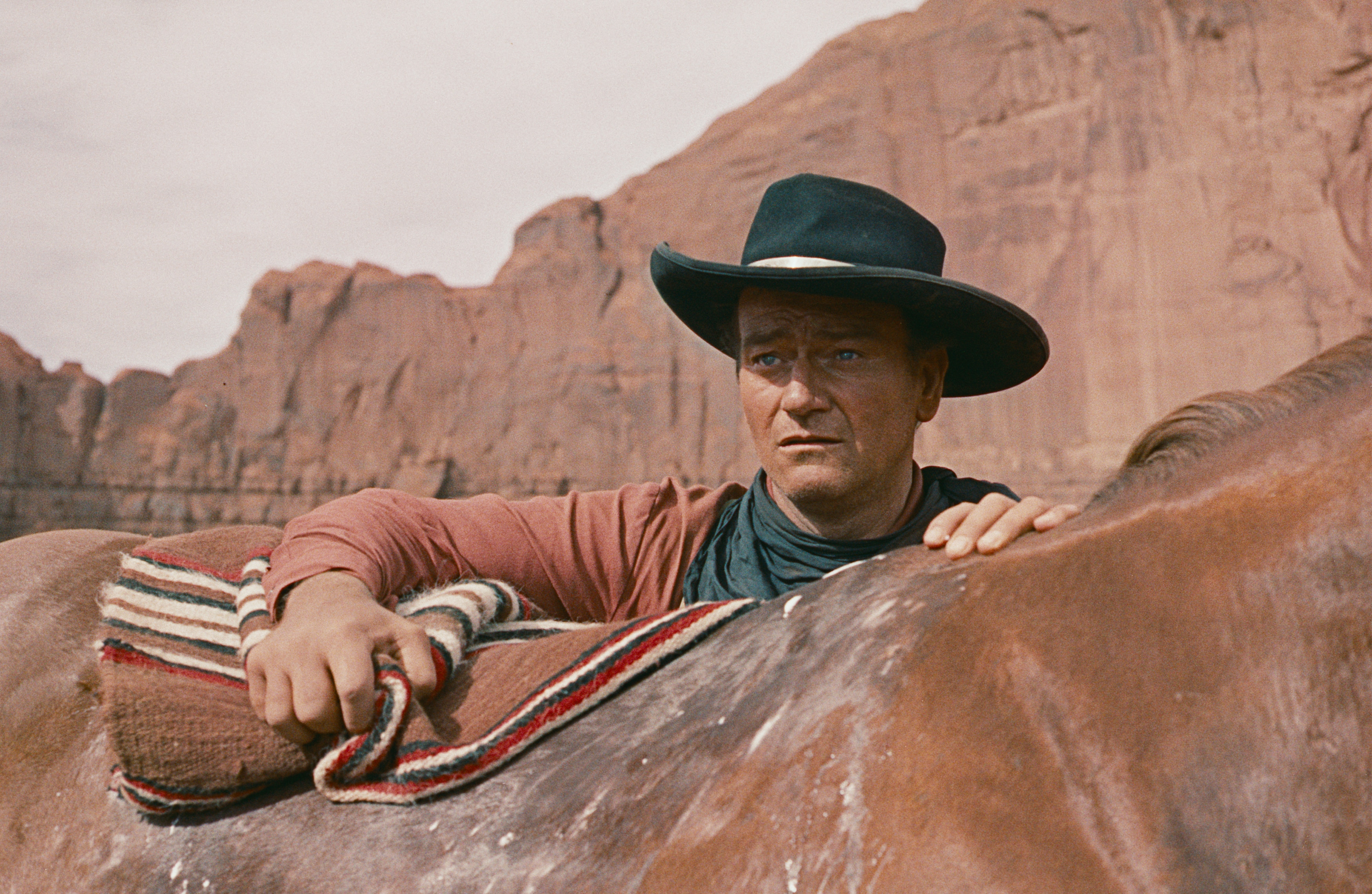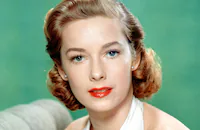The Searchers

Brief Synopsis
Cast & Crew
John Ford
John Wayne
Jeffrey Hunter
Vera Miles
Ward Bond
Natalie Wood
Film Details
Technical Specs

Synopsis
Martha Edwards opens the door of her cabin to the arid Texas landscape outside just as her brother-in-law, Ethan Edwards, approaches on horseback. Although it is 1868, Martha, her husband Aaron, their children Debbie, Lucy and Ben, and their adopted son, Martin Pawley, have not seen Ethan since he left them to fight for the Confederacy during the Civil War. Because Martin, an earnest but friendly young man, is part Cherokee, Ethan treats him coldly, even though it was he who rescued the lad when his parents were massacred in an Indian raid years earlier. Soon after Ethan's arrival, Rev. Samuel Johnson Clayton, a captain in the Texas Rangers as well as an old family friend, announces that the cattle of local rancher Lars Jorgensen have been stolen. Although Ethan is somewhat contemptuous of Sam, he joins Martin and a posse in pursuit of the thieves. When they find that the bulls have been killed with Comanche lances, Ethan declares that what the Indians really wanted was to lure the men away from home, thereby leaving their ranches open to attack.
The men head back, but it is too late, for upon their arrival at the Edwards home, they discover that everyone has been brutally murdered except for Lucy and Debbie, who have been taken by the Comanche. The posse then sets out to find the girls. On finding a fresh Comanche grave, the men unearth the body but are shocked when Ethan shoots out its eyes. According to Comanche belief, Ethan explains, this will prevent the dead man's spirit from entering the spirit lands and force him to wander forever. The next day, the Comanche raiding party, led by Chief Scar, surrounds and attacks the posse, but the rangers drive them off. When Sam refuses to pursue the Comanche, explaining that they should be allowed to bury their dead in peace, Ethan explodes, and storms away from the men, intending to continue the search on his own.
Both Martin, who endures Ethan's insults for the sake of his missing sisters, and young Brad Jorgensen, who loves Lucy, insist on joining him. One day, Brad returns from a scouting mission and joyfully announces that he has seen Lucy's blue dress at a nearby Indian encampment. Ethan reveals that he found Lucy's body and covered it, then angrily warns Brad never to ask him to reveal more. Wild with grief, Brad rides into the Indian camp and is shot to death while Ethan and Martin look on in horror. One year later, Ethan and Martin visit the Jorgensen ranch, and Ethan admits to Lars that they have lost the war party's trail. Lars replies that a Texas merchant named Futterman claims to have knowledge of Debbie's whereabouts. Meanwhile, Martin confides in Lars's daughter Laurie, who is in love with the young man, his fears that Ethan may kill Debbie because of her long association with the Comanche. To Laurie's dismay, Martin then leaves to follow Ethan, who has departed without a word. The two give Futterman money in exchange for the news that Debbie is held captive by Scar. That night, Futterman tries to shoot Martin and Ethan, but Ethan kills him and his henchmen, then retrieves his money.
Time passes, and Laurie, who is now being courted by the bumbling Charlie McCorry, receives her only letter from Martin. In it, he confesses that he inadvertently "bought" a squaw he named Look, who trembled when he asked her about Scar, but left him an arrow fashioned of rocks before leaving him during the night. Later, Martin and Ethan discover that Look joined the Comanche but was killed when the band was raided by the U.S. Cavalry. Ethan and Martin examine the prisoners taken during the raid, but do not find Debbie among the several white women found living with the Indians. His voice tinged with loathing, Ethan watches the women and remarks, "They ain't white anymore. They're Comanche." In a New Mexico cantina, the two searchers meet Mose Harper, a dull-witted but loyal old friend who, in exchange for the promise of a comfortable rocking chair, introduces them to Mexican Emilio Figueroa, who claims to know Scar. Emilio takes them to Scar's village, where they finally meet their elusive enemy, who explains that because his two sons were killed by white men, he has taken many white scalps in revenge.
One of his wives, a young white woman, then displays some of the scalps on a pole. Later that day, Ethan and Martin are visited by the woman, who, although admitting she is Debbie, begs them to leave and states that the Comanche are now her people. Disgusted that Debbie has been "living with a buck," Ethan aims his gun at her, but Martin steps between them. At that moment, Scar attacks, and while Debbie runs back to the Indians, Ethan and Martin escape. Ethan eventually recovers from a gunshot wound received during the encounter, and the two return to the Jorgensen ranch, just as Laurie and Charlie are about to exchange marriage vows. Laurie is thrilled at the return of the man she really loves, but Charlie is angry and challenges Martin to a fight. The altercation ends amicably, and Charlie calls off the wedding. Clayton, who was planning to marry the couple, assumes his role as the local lawman and arrests Martin and Ethan for the apparent murder of Futterman.
Just then, cavalry lieutenant Greenhill arrives with orders from Col. Greenhill, the flustered young officer's father. The rangers are to join the colonel in the field for a "joint punitive action" against the Comanche. Greenhill brings in Mose, who has been held captive by Scar. Injured and shaken, Mose reveals Scar's location, whereupon the men immediately prepare for a surprise attack. Worried that Debbie will be killed in the coming battle, Martin sneaks into Scar's camp to rescue her, even after Ethan reveals that one of the scalps on Scar's pole belonged to Martin's mother. When Martin enters Debbie's tent, she screams but admits that she wants to leave. When Scar appears, Martin shoots him, and Sam and the rangers attack the camp.
Ethan finds Scar's lifeless body and scalps it, after which he begins to chase the frantic Debbie. As the battle rages around them, Martin tries to stop Ethan, but Ethan catches Debbie and, instead of killing her, suddenly lifts her into the air, tenderly cradles her in his arms and says, "Let's go home, Debbie." Sam and his rangers win the battle, after which everyone returns home. Ethan delivers Debbie to Mrs. Jorgensen's tearful embrace, and Laurie joyfully greets Martin, while Mose, looking on from his rocking chair, smiles. Ethan surveys the scene from the door of the house, turns around and slowly walks away.

Director

John Ford
Cast

John Wayne

Jeffrey Hunter

Vera Miles

Ward Bond

Natalie Wood

John Qualen
Olive Carey

Henry Brandon

Ken Curtis

Harry Carey Jr.

Antonio Moreno
Hank Worden
Beulah Archuletta
Walter Coy

Dorothy Jordan
Pippa Scott
Pat Wayne

Lana Wood
Robert Lyden
Bill Steele
Cliff Lyons
Jack Pennick

Peter Mamakos
Away Luna
Billy Yellow
Bob Many Mules
Exactly Sonnie Betsuie
Feather Hat Jr.
Harry Black Horse
Jack Tin Horn
Many Mules Son
Percy Shooting Star
Pete Gray Eyes
Pipe Line Begishe
Smile White Sheep
Ruth Clifford
Dan Borzage
Crew
James Basevi
Frank Beetson
Lee Bradley
George Brown
Billy Cartledge
Merian C. Cooper
Murray Cutter
Lowell J. Farrell
Patrick Ford
Victor Gangelin
Robert Gary
Alfred Gilks
James Gooch
Chuck Hayward
Slim Hightower
Winton C. Hoch
Dudley Holmes
Frank Hotaling
Stan Jones
Fred Kennedy
Hugh Mcdowell
Frank Mcgrath
Jack Murray
Frank S. Nugent
Web Overlander
Ann Peck
Chuck Roberson
Fae Smith
Wingate Smith
Max Steiner
Dale Van Sickle
C. V. Whitney
Henry Wills
Howard Wilson
Terry Wilson

Photo Collections
Videos
Movie Clip







Trailer
Hosted Intro






Promo
Film Details
Technical Specs

Articles
The Searchers
Film critic and filmmaker Jean-Luc Godard once said of The Searchers: "How can I hate John Wayne upholding [Barry] Goldwater and yet love him tenderly when abruptly he takes Natalie Wood into his arms in the last reel of The Searchers?" This sentiment was also voiced by film students in the late sixties and seventies who began to revise their opinions of John Wayne after seeing him in John Ford's most mythic film, one that was largely misunderstood when it was first released in 1956 and features what is possibly Wayne's finest performance.
In a 1979 New York magazine article, Stuart Byron called The Searchers the "Super-Cult Movie of the New Hollywood." This amply encapsulates just one reason why the film is essential; it had a tremendous influence on filmmakers during the 1970s, arguably one of the most creatively periods in Hollywood history. Directors and screenwriters as varied in background and style as Steven Spielberg, Martin Scorsese, John Milius, Paul Schrader, Wim Wenders, Jean-Luc Goddard, and George Lucas have all been influenced and paid some form of homage to The Searchers in their work. Scorsese, perhaps the greatest filmmaker of his generation, exclaimed, "The dialogue is like poetry! And the changes of expression are so subtle, so magnificent! I see it once or twice a year." Scorsese's Taxi Driver (1976) obviously shares some narrative similarities with the Ford film as does Paul Schrader's Hardcore (1979). Spielberg, one of the most profitable film producer/directors in movie history, told Stuart Byron he had watched The Searchers a dozen times, including twice while on location for Close Encounters of the Third Kind (1977). And it was in the late fifties when seventh grader Spielberg shot a two-reel Western in a friend's backyard imitating The Searchers, using a backdrop of Ford's beloved Monument Valley painted on a bedsheet. You can even see references to Ford's masterpiece in the work of Italian director Sergio Leone who stages a massacre scene in his epic, Once Upon a Time in the West (1969), that is remarkably similar to the one that destroys Ethan's kin in The Searchers.
The Searchers represents the apex of the Western genre and stands as John Ford's most emotionally complex and sophisticated film (It was also his 115th feature film!). But it is not simply a summation of the Western themes that Ford had previously explored in his films. The Searchers is one of the first Westerns to deal in a serious and unpretentious way with racism and sexuality. As Joseph McBride wrote in his monumental Ford biography, Searching For John Ford, the director's decision to tackle such a complicated and ambiguous film dealing with race and sex during the 1950s "was a shrewd career move, showing a willingness to make a more 'modern'-seeming Western for an audience that wanted greater psychological realism from the genre..." But more than just making a social statement like other Westerns of the period were apt to do, Ford instills in The Searchers a visual poetry and a sense of melancholy that is rare in American films and rarer still to Westerns.
For an essay in The International Dictionary of Films and Filmmakers, film scholar Ed Lowry wrote: "Never before in a Ford western has the wilderness seemed so brutal or settlements so tenuous and threatened. There are no towns - only outposts and isolated homesteads, remote and exposed between the awesome buttes of Ford's mythic Monument Valley. And while the Comanches are depicted as utterly ruthless, Ford ascribes motivations for their actions, and lends them a dignity befitting a proud civilization. Never do we see the Indians commit atrocities more appalling than those perpetrated by the white man. Not only does [Ethan] Edwards perform the only scalping shown in the film, but Ford presents the bloody aftermath of a massacre of Indian women and children carried out by the same clean-cut cavalrymen he depicted so lovingly in films like Fort Apache." For most viewers, however, it is John Wayne's performance in The Searchers that is a revelation. "I've always thought [Wayne is] underrated as an actor," James Stewart once said. "I think The Searchers is one of the most marvelous performances of all time."
Producer: C. V. Whitney, Merian C. Cooper
Director: John Ford
Screenplay: Frank S. Nugent, based on the novel by Alan Le May
Cinematography: Winton C. Hoch
Film Editing: Jack Murray
Art Direction:
Music: Max Steiner
Cast: John Wayne (Ethan Edwards), Jeffrey Hunter (Martin Pawley), Vera Miles (Laurie Jorgensen), Ward Bond (Captain Reverend Samuel Clayton), Natalie Wood (Debbie Edwards), John Qualen (Lars Jorgensen), Olive Carey (Mrs. Jorgensen), Henry Brandon (Scar), Ken Curtis (Charlie McCorry), Harry Carey, Jr. (Brad Jorgensen), Hank Wordon (Mose Harper).
C-119m. Letterboxed.
by Scott McGee

The Searchers
Quotes
Our turnin' back don't mean nothin', not in the long run. She's alive, she's safe for a while. They'll keep her and raise her as one of their own til, until she's of an age to... Injun will chase a thing till he thinks he's chased it enough. Then he quits. Same way when he runs. Seems like he never learns there's such a thing as a critter that'll just keep comin' on. So we'll find 'em in the end, I promise you. We'll find 'em. Just as sure as a turnin' of the earth.- Ethan
Ethan, I gotta ask you and Martin to take a ride to State Capital.- Reverend Clayton
Is this an invite to a necktie party, Reverend?- Ethan
Well Reverend, looks like you've got yourself surrounded.- Ethan
Yeah and I figure on getting myself unsurrounded.- Reverend Clayton
I say we do it my way. That's an order!- Reverend Clayton
Yessir. But if you're wrong don't ever give me another.- Ethan
You wanna quit Ethan?- Reverend Clayton
That'll be the day.- Ethan
Trivia
One of the first movies to market itself with a making-of documentary aired on TV. Gig Young hosted the program, which introduced new hearthrob 'Hunter, Jeffrey' .
In the climactic scene, 'Wayne, John' and 'Wood, Natalie' run up the side of a hill in Monument Valley, Utah... and come down the other side of the hill in Bronson Park, Los Angeles (1,200 miles away!).
Western star Harry Carey died in 1947. Director Ford cast Carey's wife (Olive) as Mrs. Jorgensen (the mother) and also Carey's son (Harry Carey Jr.) as one of the sons (Brad) as a tribute to Carey. In the closing scene with John Wayne framed in the doorway, Wayne holds his right elbow with his left hand in a pose that Harry Carey fans would recognize as one that Carey often used. Wayne later stated he did it as a tribute to Harry Carey. Off-camera, Olive Carey watched.
Lana Wood played young Debbie Edwards and Natalie Wood who was Lana's older sister of 8 years played teenaged Debbie Edwards.
The Mexican man who takes the searchers to meet Chief Scar is called Emilio Gabriel Fernandez y Figueroa. The name of this character played by Antonio Moreno is a combination of the names of Mexican actor and director Emilio Fernandez and his cinematographer 'Gabriel Figueroa' .
Notes
Alan Le May's best-selling novel, on which the film was based, was serialized in The Saturday Evening Post under the title The Avenging Texans from 6 November to December 3, 1954. The Hollywood Reporter review gives the film's running time as 110 min. According to a April 1, 1955 Hollywood Reporter news item, some scenes were shot on location in Canada and Colorado. Hollywood Reporter production charts noted that the majority of location shooting was done in Monument Valley, UT, while studio sequences were shot at RKO-Pathé. Several modern sources add Bronson Canyon in Los Angeles' Griffith Park as a shooting site.
The Searchers was the first film produced by C. V. Whitney Pictures. Whitney, a well-known sportsman and millionaire, had previously been a partner with David O. Selznick in Pioneer Pictures and other ventures, including the production of Gone With the Wind and the formation of the Technicolor company. Whitney also had a long association with producer Merian C. Cooper, one of director John Ford's partners in Argosy Pictures.
Ford's son Patrick acted as the associate producer and his son-in-law, Ken Curtis, played "Charlie McCorry"; John Wayne's son Pat played "Lt. Greenhill"; and Lana Wood, who played "Debbie" as a young girl, was actress Natalie Wood's sister. Olive Carey and Harry Carey, Jr. were the widow and son of the late western actor Harry Carey, who was a longtime friend of and major influence on both Ford and Wayne. Many modern film critics have pointed out that in the final shots of The Searchers, when Wayne is seen in the doorway, he paid tribute to Carey by grasping his right elbow with his left hand, a gesture that Carey often made in his pictures.
Although their appearance in the film has not been confirmed, Hollywood Reporter news items add the following actors to the cast: Mae Marsh, Gertrude Astor, Peter Ortiz and Maj. Philip Kieffer. In his autobiography, Iron Eyes Cody states that he also was in the film, but he was not identifiable in the print viewed.
The film received mostly positive reviews, although some reviewers commented negatively on the complexity of the "Ethan Edwards" character and the lack of explanation of his actions. According to an early plot synopsis contained in the film's file in the MPAA/PCA Collection at the AMPAS Library, Ethan's rescue of "Debbie" at the film's end was to be explained by his statement that she resembled her late mother, with whom Ethan was in love. Although many modern critics have noted an implied romantic relationship between Ethan and "Martha," it is only vaguely hinted at in the film.
The Searchers was a financial success, but it did not receive any Academy Award nominations. However, in 1971 Peter Bogdanovich produced and directed a documentary on Ford, Directed by John Ford, that utilized the opening and closing of The Searchers, and in 1972, a Sight and Sound poll of international film critics included it on a list of the twenty best films of all time, and a number of modern directors have cited the picture as an influence on their work. In 1991, Warner Bros. released a thirty-fifth anniversary video edition of the film, which included documentary footage of the making of The Searchers. The footage was broadcast on several segments of the 1956 Warner Brothers Presents television program. In 1998, The Searchers was rated number 96 in the AFI's list of the 100 greatest movies of the century.

Miscellaneous Notes
Released in United States 1973
Released in United States March 1976
Released in United States May 1989
Released in United States Spring May 1956
Shown at Film Forum in New York City May 25 & 26, 1989.
Broadcast in USA over The Family Channel September 24, 27, & 30, 1995.
Released in USA on video.
Selected in 1989 for inclusion in the Library of Congress' National Film Registry.
VistaVision
Released in United States 1973 (Shown at FILMEX: Los Angeles International Film Exposition (Great American Films) November 15 - December 16, 1973.)
Released in United States March 1976 (Shown at FILMEX: Los Angeles International Film Exposition (The 48-Hour Cowboy Movie Marathon) March 18-31, 1976.)
Released in United States Spring May 1956
Released in United States May 1989 (Shown at Film Forum in New York City May 25 & 26, 1989.)















